Did you know that using push notifications is one of the most effective ways to get visitors back to your website?
Web push notifications are a powerful tool for connecting with visitors after they leave your site. They allow you to send targeted messages to your users, which leads to more traffic, conversions, and sales.
In fact, push notifications are one of our top 5 traffic sources at WPBeginner, and they bring up to 10,000 visitors per month to our website.
We’ve found it super easy to set up push notifications with PushEngage, which is why we use it across all our brands. But we have also tested out a bunch of other push notification software options to see if they are worth the price.
And in this article, we will share our pick of the best web push notification software for your website.
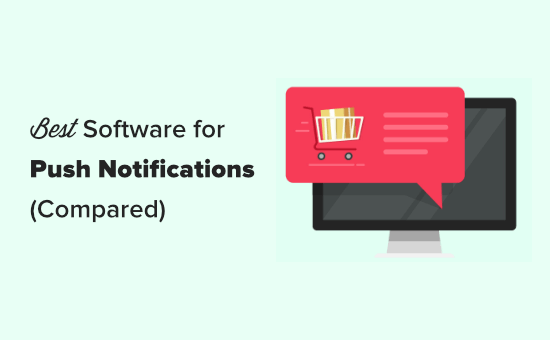
Quick Pick: The Best Push Notification Software
If you’re in a hurry, then you can check out our quick pick of the best push notification software below:
| Ranking | Plugin | Best For | Starting Price |
|---|---|---|---|
| 🥇 | PushEngage | All kinds of websites | Free + $9 / month |
| 🥈 | OneSignal | Multi-platform support | Free + $9 / month |
| 🥉 | VWO Engage (PushCrew) | Complex notifications | Free + custom pricing |
| 4 | iZooto | Personalized notifications | Free + $85 / month |
| 5 | Webpushr | Most subscribers on free plan | Free + $29 / month |
| 6 | PushAssist | Unlimited notifications | Free + $9 / month |
| 7 | WonderPush | eCommerce websites | €1 per month |
Why Use Push Notifications?
Push notifications allow you to engage and retain visitors after they leave your website.
You can send targeted, personalized messages to users and bring them back to your website. These could be blog post notifications, product announcements, abandoned cart reminders, and more.
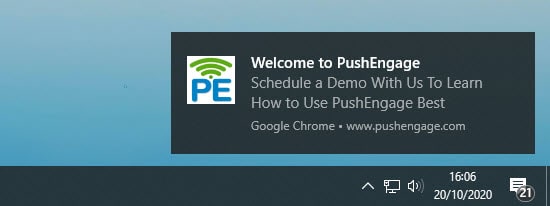
Push notifications go directly to the user’s web browser or mobile device, which means they have a much higher engagement rate, similar to SMS messages.
Many big sites like Facebook use push notifications. However, most small businesses haven’t yet realized how powerful they are. On the WPBeginner website, push notifications are consistently a top 5 traffic source, so we recommend them to all bloggers and website owners.
If you’re not using push notifications, then now is a great time to start so you can get ahead of your competition.
How We Tested and Reviewed Push Notification Software
We have been using PushEngage on WPBeginner for a long time, but we wanted to make sure that we reviewed all the best options for our readers. So, we tested out other push notification software and paid attention to these criteria:
- Types of push notifications: We prioritized software that lets you make all kinds of push notifications, including geolocation, cart abandonment, event, and personalized notifications.
- Integrations and platform support: We looked for software that supports notifications on all the platforms you might need, including iOS, Android, and all popular web browsers. Plus, we picked options that can integrate with the platforms you need to use, especially WordPress and CRM software.
- Ease of use: Push notifications can be tricky to set up if you’re not a developer. That’s why we looked for software that allows you to create them without needing to learn coding.
- Pricing: We looked for software options that have free plans and affordable paid plans for small businesses.
- Ratings and reviews: Although we tested each push notification software option ourselves, we also had a look at customer ratings and reviews. This allowed us to find common issues faced by real customers.
Why Trust WPBeginner?
At WPBeginner, our team has 15+ years of experience in online marketing, including push notifications, email marketing, and content marketing.
During our WordPress journey, we’ve tested out plenty of software to find the best options for small businesses so that we can share our findings. We are also committed to uncovering the real pros and cons of each option so that we can give balanced advice to our readers.
For more details, see our complete editorial process.
1. PushEngage
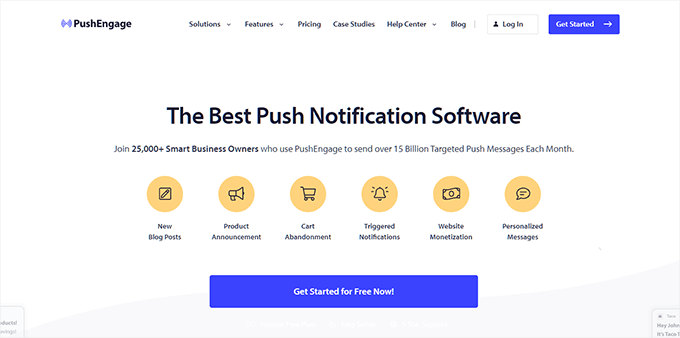
PushEngage is the overall best push notification tool on the market, and it’s hands-down the best option for beginners. We personally use it on WPBeginner and our other brands, and we have been consistently impressed by how easy it makes it to reconnect with visitors after they leave your website.
You can set it up to automatically send new blog post notifications or use it to manually send custom messages.
We like that PushEngage makes it super easy to set up web push notifications and is a perfect solution for both beginners as well as advanced users. It works on both HTTP and HTTPs websites, and supports all devices / browsers.
We also appreciate its marketing-specific features that allow us to increase conversions, such as A/B testing, automatic drip campaigns, smart opt-in reminders, custom-triggered campaigns, interactive message options, and more.
PushEngage’s marketing automation feature, triggered campaign, lets you automatically create abandoned cart notifications, schedule messages, send price drop alerts, create browser abandonment campaigns, and more.
Plus, you can track the metrics of each campaign and even calculate the transactional revenue generated from push notifications using goal tracking.
PushEngage’s dynamic segmentation helps you send more targeted messages based on users’ actions. For example, you can segment visitors who added products to the cart, bought something, viewed a specific page, and more.
This level of personalization helps you get maximum results, so you get more traffic and sales.
We have also been impressed by its powerful pop-ups, which help you get more subscribers faster, and its smart resubscribe feature helps with user re-engagement and retention.
The best part is that PushEngage works on all devices: desktops, tablets, and smartphones (iOS and Android) without you creating a separate mobile app.
Pros:
- PushEngage is very easy to use for beginners and has a code-free integration for WordPress and WooCommerce.
- It provides advanced segmentation rules, marketing automation rules, and popups to improve conversions.
- PushEngage has detailed analytics to get the most out of your campaigns.
- It has excellent and responsive customer support.
- Affordable pricing.
Cons:
- While there is a free plan, you will need to upgrade to a paid plan to get access to advanced features.
Why we recommend PushEngage:
PushEngage is perfect for bloggers, startups, and eCommerce websites that are looking to boost user engagement and increase overall conversion rates.
For larger companies looking to integrate web push notification service with their CRM, PushEngage also offers a powerful API that can be leveraged in omnichannel customer lifecycle marketing campaigns.
To learn more about this powerful software, see our detailed PushEngage review.
Price:
PushEngage pricing starts at $9/month, which gives you 50,000 subscribers and unlimited notifications. There’s also a limited free plan, which gives you up to 200 subscribers and 30 campaigns per month.
Editor’s note: Our founder, Syed Balkhi, fell in love with this marketing platform because of the impact it had on our business. In October 2020, we acquired PushEngage, and it’s now part of WPBeginner’s family of products.
2. OneSignal
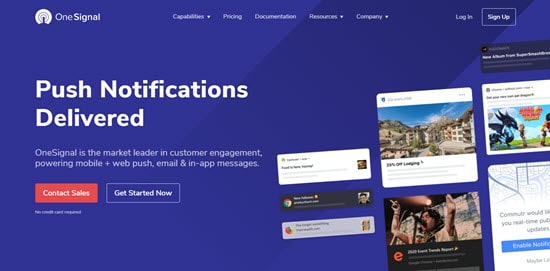
OneSignal is a popular push notification tool with similar features to PushEngage. But it integrates with a higher number of platforms, so it could be a good option if integrations are your top priority. That being said, PushEngage has better automation features, so it will come down to your business’s specific needs.
With OneSignal, you can create automatic push notifications, announcements, abandoned cart notifications, and more.
You can easily set your push prompt to display after a certain number of page views and/or seconds. This means you don’t need to display the push prompt the moment someone arrives on your site.
Along with offering push notifications, OneSignal lets you create in-app messages, app push notifications, and emails. Like PushEngage, OneSignal offers A/B testing and useful analytics. You can also segment your audience for better targeting.
One key drawback to OneSignal is that it gets expensive as you need more features. It also has fewer automation, personalization, and customization options than PushEngage.
However, they do have app messaging, mobile push notifications for app developers, and now email, which allows for multi-channel marketing.
Pros:
- OneSignal is great for omnichannel marketing.
- It has great segmentation settings to create personalized push notifications.
- It excels for in-app messaging.
Cons:
- It can get pretty expensive as your business scales.
- Some customers have reported issues with technical support.
Why we recommend OneSignal:
Overall, OneSignal is a great option for multi-channel marketing. It isn’t the cheapest option, but it allows you to reach your visitors across a high number of platforms and bring them back to your website.
Price:
OneSignal’s Growth plan starts at $9 per month for 1,000 subscribers which gives you their standard personalization and key features.
Their professional plan starts at $99 per month and adds journeys, a larger number of message personalization options, and some of their more advanced functionality.
They have a limited free plan available that allows for up to 5,000 email sends, but it’s limited in personalization and optimization features.
3. VWO Engage (PushCrew)
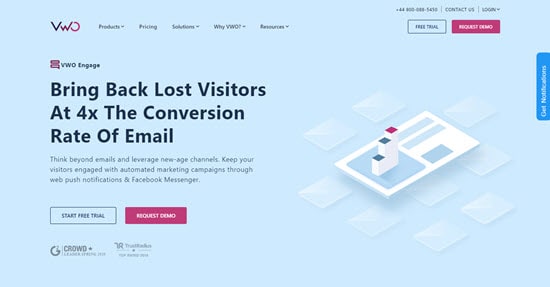
VWO Engage, which used to be called PushCrew, is a good software option if you are looking to set up more complex push notification campaigns. We tested it out for this review, and we were impressed by the different kinds of notifications that it allows you to set up.
It’s designed to let you create push notification campaigns with entry and exit triggers. That means the campaign can automatically start based on the user’s actions, such as clicking a particular link.
Users can also automatically opt out of the campaign when they take a set action, such as clicking a button or filling out a form.
VWO Engage offers segmentation, click-through analytics, personalized notifications, and A/B testing. In particular, we liked their advanced cross-platform personalization options, which can help you target your audience with the most impactful notifications.
That being said, VWO Engage can be tricky to use if you are not that tech-savvy. It has a pretty steep learning curve, so it may not be a good fit for complete beginners.
Pros:
- VWO Engage is ideal for complex and personalized push notification campaigns, especially triggered campaigns.
- It includes A/B testing to see the effectiveness of your campaigns.
- You can link the software with your RSS feed to send automated push notifications after publishing new content.
Cons:
- It’s not the best option for beginners because its push notifications can be difficult to set up.
- It is a bit more expensive than some of the other push notification software options on our list.
Why we recommend VWO Engage:
VWO Engage (PushCrew) is a good option for larger businesses with dedicated development teams. It is a more technical software option that allows you to set up complex and super-personalized push notifications.
Price:
VWO Engage pricing starts at $99/month. This gives you up to 10,000 subscribers and unlimited notifications.
There’s no free plan available. However, you can take a free trial for 30 days, with no credit card required.
4. iZooto
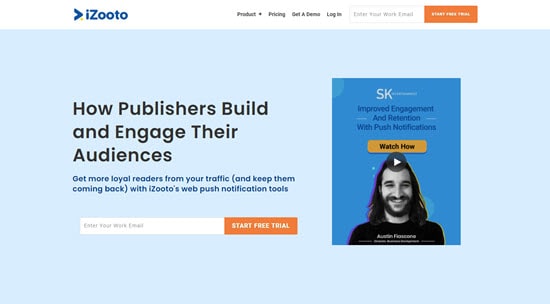
iZooto is a top choice if your priority is personalized push notifications. When testing the platform, we were impressed by how much personal data it allows you to collect from visitors through its optins.
It offers real-time push notifications, recurring notifications, and scheduled notifications. You can also set up segmentation for more targeted messaging.
It includes A/B testing, timezone-based notifications, capturing key user attributes and interests, and more.
Your initial push prompt can appear when the user scrolls down, after a certain length of time, or after a button click. This can help you increase the percentage of site visitors signing up for push notifications.
If you’re already using a different push notification tool, the iZooto customer success team will help you transfer over your subscribers.
Keep in mind that iZooto only works with HTTPS websites, which means your site needs to be using an SSL certificate. Plus, it is one of the more expensive software options on this list.
Pros:
- iZooto offers free retargeting to capture users’ attention more effectively.
- The software is easy to use.
- It comes with a monetization feature that allows users to make money through push notification ads.
Cons:
- It could be a bit too expensive for small businesses.
- It has a small number of templates for push notifications.
Why we recommend iZooto:
If your priority is personalized notifications, then iZooto is worth considering. However, because of its higher pricing, it’s better suited to mid and large-sized businesses.
Price:
iZooto pricing starts at $85/month, which gives you up to 30,000 subscribers and unlimited notifications.
There’s no free plan available. However, you can take a 14-day free trial (no credit card required).
5. Webpushr
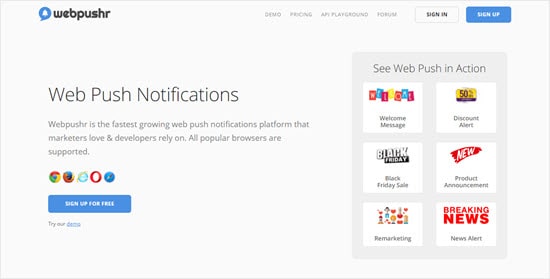
Webpushr is a straightforward web notifications platform that supports all popular browsers. It offers a range of different prompt templates that you can customize.
Webpushr makes it easy to transfer subscribers from another platform. It includes features like user segmentation, automatic web push, and HTTP support. Plus, it’s designed to integrate seamlessly with both WordPress and WooCommerce.
Webpushr gives you unlimited team members and unlimited segments for your subscribers. It also supports large images, action buttons, emojis, and custom branding.
Unlike most push notification plugins, Webpushr offers all the features on all plans, including their free plan. The only difference is the number of subscribers you can have. But keep in mind that paid plans can get quite expensive as the number of subscribers increases.
Pros:
- All features are offered on the free plan, so it’s an affordable option for small businesses.
- It is straightforward and easy to use for beginners.
- Webpushr is an ideal choice for WooCommerce stores.
Cons:
- Its plans can get expensive quickly as you get more subscribers.
Why we recommend Webpushr:
Webpushr is a good option if you are just starting out, as you can take advantage of all of its features on the free plan. It’s also easy to use, making it a suitable choice for beginners.
Price:
Webpushr pricing starts at $29/month for up to 50,000 subscribers and unlimited notifications.
There’s also a free plan available. This gives you up to 10,000 subscribers and unlimited notifications.
6. PushAssist
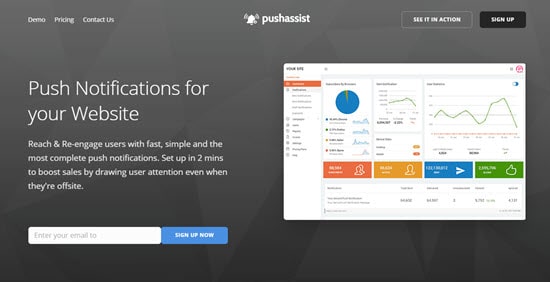
PushAssist is a push notification tool that supports Chrome, Firefox, and Safari browsers. And out of all the software we tested, it is the only one that offers an unlimited number of push notifications on the free plan.
It’s easy to set up and works on both desktop and mobile.
With PushAssist, you get audience segmentation, personalization, scheduling tools, and insights into your customer data.
You also have the option to monetize your push traffic by letting advertisers send out push notifications to your audience. This could help you make money online.
You can use PushAssist with an HTTP or HTTPS website. However, you cannot remove the PushAssist branding unless you’re using the Business plan or higher.
Pros:
- It is budget-friendly for small businesses.
- The PushAssistant support team is helpful and responsive.
- You can become a publisher partner and monetize your push notifications by showing ads in them.
Cons:
- The free plan puts PushAssist branding on your push notifications.
Why we recommend PushAssist:
PushAssist is a good choice if you need to send a high number of push notifications since you won’t be limited on any of its plans.
Price:
PushAssist costs from $9/month for up to 3,500 subscribers.
There’s also a free plan available. This gives you up to 3,000 subscribers and unlimited notifications.
7. WonderPush
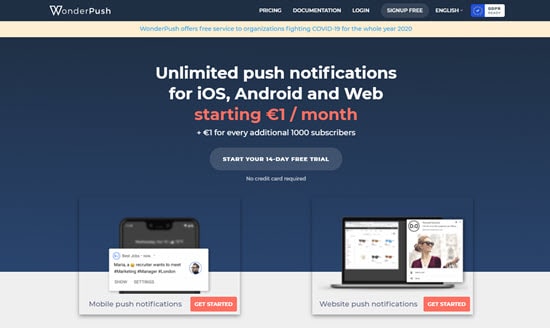
WonderPush is a great push notification software for online stores and eCommerce websites. During testing, we were impressed by all the kinds of eCommerce notifications you can set up, including automated abandoned cart notifications.
It works in a similar way to most other push notification plugins. It lets you segment your subscribers, automate notifications based on behavior or time, access real-time analytics, and more.
You get all the features however much you’re paying. These include unlimited staff members, unlimited notifications, A/B testing, personalization, and more.
Pros:
- It’s a great option for WooCommerce and other eCommerce stores.
- You can add an unlimited number of members to your dashboard, making it ideal for larger teams.
- It is user-friendly and suitable for beginners.
Cons:
- WonderPush doesn’t offer bulk pricing for the higher plans, so it’s not great for large businesses.
- Its support and documentation are not as good as other push notification software options.
Why we recommend WonderPush:
WonderPush is a great option if you are running an online store. It’s pretty easy to use, and it can help you turn visitors into paying customers.
Price:
WonderPush has a pricing model that is different from the other tools we’ve featured. It costs from €1 per month for up to 1,000 subscribers, and then it’s an extra €1 for every 1,000 subscribers after that.
There’s no free plan, but you can take a 14-day free trial. This doesn’t require a credit card.
Which Is the Best Push Notification Software?
PushEngage is the best push notification software on the market. It’s beginner-friendly and easy to get started with, yet it also offers lots of powerful features.
Their free plan is suitable for small businesses and blogs. Their pricing is the most competitive as it scales, which is a big reason why many large businesses use PushEngage marketing software. Their platform is robust, and the support team is top-notch.
OneSignal can be a good fit, too. However, their free plan is quite limited, and even the paid plans have fewer features and customization options.
Regardless of the platform you choose, we strongly recommend that you implement push notifications in your business today. They will help compound the results you’re already getting from SEO, social media, and other customer engagement channels.
Video Tutorial
We hope this article helped you learn about the best push notification software for websites. You might also like our article on the best email marketing services and the best business phone services for your small business.
If you liked this article, then please subscribe to our YouTube Channel for WordPress video tutorials. You can also find us on Twitter and Facebook.
Disclaimer: To help readers avoid choice paralysis, we only included what we believe are the best web push notification software in the market. This list doesn’t include other providers like Airship, Sendpulse, Pushwoosh, and other solutions that exist on the market.





Jiří Vaněk
There is also a service of this type with the option of trying it out or using it for free for a smaller number of users. Dozens or very low count of hundreds (eg 300)?
WPBeginner Support
Some of the tools in this list have a free option for testing but you would need to check with the support for the current limitations and availability.
Admin
Jiří Vaněk
Thanks for the reply and I will look into the tools in question. I would very much like to try this type of notification on a few users, but I would not like to pay a subscription unnecessarily for it. Thanks
Moinuddin Waheed
push notifications are great and highly effective way to get the visitors on the blog.
it ensures that every posts and important notification get through the visitors notice.
However it should be used with a little caution as it may backfire if too much push notifications gets into the way.
I will give a try to push engage given its potential and effectiveness.
Stanley Ozuzu
Have been using OneSignal for quite some time, I can it pretty much does the job.
WPBeginner Support
Glad to hear you found the one that works for you!
Admin
Brian Yatich
Is it advisable to have two web pushers?
WPBeginner Support
You would normally only want to have one per site.
Admin
Vasudeva
Very useful articles. I will try Pushengage free version and if satisfied, subscribe to one of their plans.
Thank you, wpbeginner.
WPBeginner Support
Glad our recommendation could help
Admin